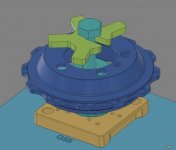Anybody ever use these or something similar?
Pull Clamp - Fixtureworks
We have a range of parts that get a final operation in a mill. It's a quick profile, hole pattern drilled, and a front/backside edge break, two parts at a time. We use an impact and a 1/2" bolt to clamp a custom cap onto the part and sandwich it in place to a locating fixture. The current system is nice because it is flexible and fast to change up for different parts, and easy to update when a brand new part gets added to the catalogue. The downside is it takes operators a minute or two to unbolt, remove cap and finished part, replace cap and new part, and rebolt. Do that 100 times a day while they're also running the other machines and it means the spindle on time is down to maybe 30%.
I'd like to replace bolts with something like this that is A) faster and B) repeatable. Originally looked at pneumatic chucks but we have too many different sizes, something like this allows us to use pretty much our same flavor of fixturing but hopefully it increases our throughput, or at least cuts down on slipping parts.
Downside I see to this particular item is it needs constant air pressure otherwise it will unclamp, but is that really even a downside? Also not really sure is the 562lb "clamping force" is a lot or not much at all...
Pull Clamp - Fixtureworks
We have a range of parts that get a final operation in a mill. It's a quick profile, hole pattern drilled, and a front/backside edge break, two parts at a time. We use an impact and a 1/2" bolt to clamp a custom cap onto the part and sandwich it in place to a locating fixture. The current system is nice because it is flexible and fast to change up for different parts, and easy to update when a brand new part gets added to the catalogue. The downside is it takes operators a minute or two to unbolt, remove cap and finished part, replace cap and new part, and rebolt. Do that 100 times a day while they're also running the other machines and it means the spindle on time is down to maybe 30%.
I'd like to replace bolts with something like this that is A) faster and B) repeatable. Originally looked at pneumatic chucks but we have too many different sizes, something like this allows us to use pretty much our same flavor of fixturing but hopefully it increases our throughput, or at least cuts down on slipping parts.
Downside I see to this particular item is it needs constant air pressure otherwise it will unclamp, but is that really even a downside? Also not really sure is the 562lb "clamping force" is a lot or not much at all...


 ) and a 1/2-13 bolt torqued to 50 ftlbs yields 4000lbs of "axial clamp force" so those aren't gonna cut it. Is there another clamp system out there that would be ideal for replacing a traditional fastener? We have a range of thicknesses on the feature that gets clamped from .216 to .669, so an adjustable length stud, or something with a range of clamping depths would be ideal.
) and a 1/2-13 bolt torqued to 50 ftlbs yields 4000lbs of "axial clamp force" so those aren't gonna cut it. Is there another clamp system out there that would be ideal for replacing a traditional fastener? We have a range of thicknesses on the feature that gets clamped from .216 to .669, so an adjustable length stud, or something with a range of clamping depths would be ideal.

